Switzerland
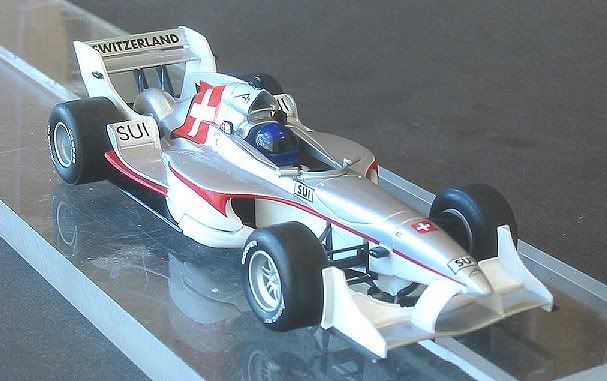
By Phil Wicks
I have done and still do what some people consider more than my fair share of slotcar racing in the course of a week. From as little as two evenings to as many as four. I also get to run some of my favourites on a wide diversity of tracks in South East Queensland. From a 60 metre plus four lane Scaley sports track right through five different surfaces to a tight and twisty four lane board track. For all the cars and tracks I use, I have to admit that, as an observation, I, or others with me, hardly ever race open wheelers?? Why would this be? Considering the latest offers from Mr Hornby are probably the most exciting to drive, no one seems to race them! I suspect that the real problems lie with the carnage and aftermath that follows a hotly contended F1/Indy/open wheeler event.
A1 GP Home
Several years back now the best fun you could have with a GP car was probably the last of the SCX pre magnet F1 series. Cars like the Jordan and Ferraris were excellent handlers on board and plastic alike. At the end of the race you were pretty well assured that the low track speed and robust construction would see your model intact. At worst, one of your wheels may have become temporarily detached. Scalextric had a few ‘fridge magnet’ models out but they were still dogged by basic handling problems. They also would shed front wings permanently in a solid front end collision. Even the thick front wings of the Williams Hondas were not exempt from damage. Then Ninco introduced their F1 range with the Ferrari 312 and Stewarts and the like. These models had a robust rear wing and a ‘drop out’ front wing which did just that in an accident (or even down a good straight for no reason?)
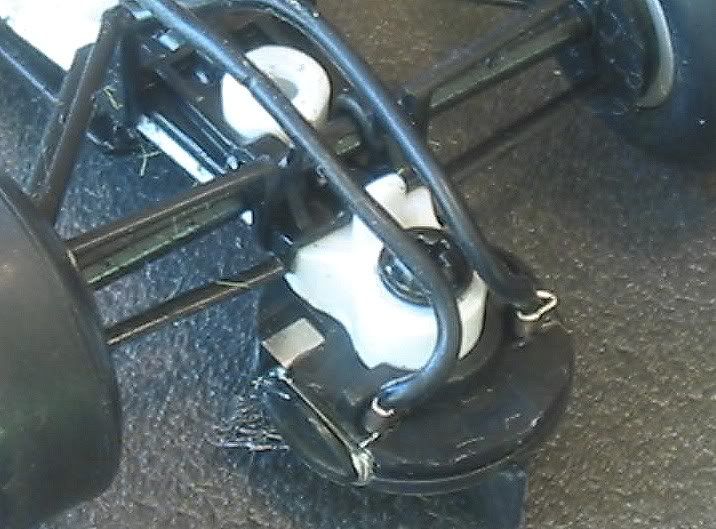
Next were the great little SCX F1s. Minardis, Arrows and the like, complete with fully functioning steering could be raced full on and quite quickly with minimal risk. The front wings clipped on and off and the rear wings again seemed to last out. Once again, the worst incident might just be a simple front wheel detachment. With the traction magnet on these adjusted downwards to just clear the conductor rails, these models could be driven at full throttle for almost the entire lap of most tracks, leaving the driver free to concentrate on a plate of chips or a conversation with an adjacent driver on what class was to be raced next!! (True!)
Then..............................?
Then came Mr Hornby’s FI’s (sound track from ‘Jaws’ playing in the background!) You heard it! My first experience with these was at a regular race night on a four lane Scaley classic track. About 35 metres in length with a couple of good straights. A couple of the guys had bought the then new Scalextric F1 slot cars. I seem to think they may have been Williams but I can’t be sure. Anyway, On to the track they went to do battle with the Nincos and the SCX’s that were top dogs at the time. Well, suffice it to say that by the end of the evening; the Scaleys were looking decidedly second hand, BIGTIME! Wings, mirrors barge boards ‘et al’ were the biggest losers and since then not a lot has changed.
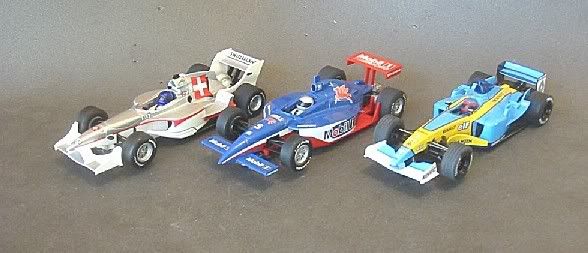
The Indy cars topped the carnage list with most models being denude of front and rear wings after one race and a succession of F1’s sees the trend persist. But just as all was looking futile, along comes the A1 GP’s! Now, at a glance, I can see some obvious advantages in the construction of the front and rear of these models. Maybe they have replicated the real article but it bodes well when the rear wing is supported on two sturdy pylons and the front wing has a substantial mounting too! No barge boards to worry about and the front suspension has a lot of flexibility too. And to top it all, the rear view mirrors are inside the ‘roll over’ zone which puts them out of harms way. Bingo. At last, an open wheeler that was designed to sustain minimal damage in all but the most serious of shunts.
Am I foolish enough to think that Scalextric have done this on purpose? Or have the A1 GP fraternity designed their real cars with us slot racers in mind!! I think not, purely coincidence, but a coincidence which might help see the resurgence of 1/32 RTR open wheeler racing. We now have a model which in the right hands may well retire from a racing career with most if not all its parts intact!!!
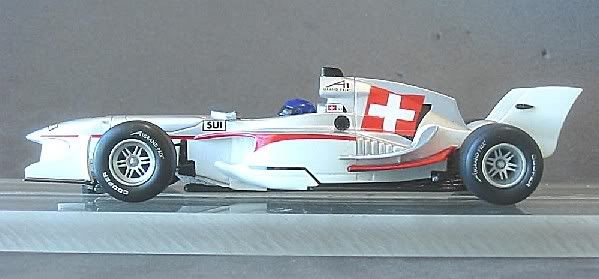
My model was a chance buy, simply because of the vulnerability of its predecessors. I was speaking to Kevin at Scalexworld, Adelaide, about spares and other things when I asked about any new models in that week. With no further ado, I asked him to include one in my parcel and four days later I was admiring it in the comfort of my lounge.
The A1 GP ‘Switzerland’ is a very ‘pretty’ car. The silver and white livery with the red of the Swiss flag is easy on the eye and easy to pick out in a bunch. The body shape designed by Lola International flows too and there aren’t a myriad of vents, foils and miniwings spread all over awaiting detachment! Just pure simplicity and, with the absence of a swag of sponsor decals, really nice. I was looking forward to running this model but firstly, a look inside to see what the business was and to check on any potential problems, I needn’t have bothered though as this model is uncomplicated and functional. The only defect visible was, even at this early stage, the yellowing discolouration of the body parts around and alongside the rear wheels?? I thought this was fixed twenty years ago?
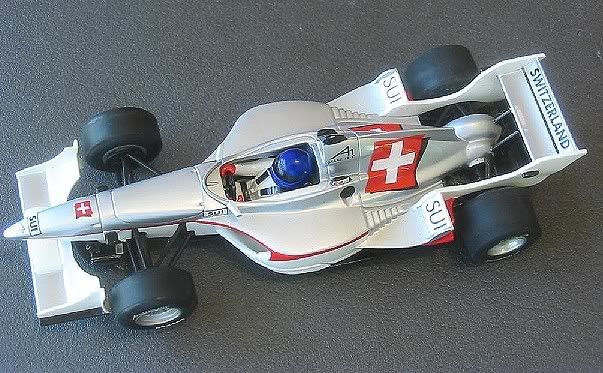
Four screws hold the chassis in place and once removed the model separates easily at the tub seam. The nylon front suspension and fixed front axle sit firmly in place on the front chassis section with the front fixing screw holding all in place. The guide is the standard Scaley round guide with quick change braid plate and again there is minimal slop in this. The ‘F’ can is well mounted and has a sliver of what looks to be a masking tape type material on its underside. No doubt this contributes to removing any mounting slack that may occur in the variances of manufacture. A long output shaft on the motor allows for a very usefully sized neodymium magnet to be mounted between motor and rear axle and finally the rear axle has sturdy mountings to the chassis. There is a little bit of slop in the rear axle bushes but no more than the vast majority of models now available.
Wheels are true and tyres fit well. On this model, the rear tyres were a bit reminiscent of the ‘90’s Scalextric tyres as far as shape was concerned and they took a bit of sanding before they were concentric? Underneath the chassis is basic and problem free. The modellers have simulated the ‘plank’ structure under the car and as described later, this did present a couple of problems. I didn’t need to make any repairs or modes to the inside of this model. I didn’t even glue the motor in, that’s how confident I was with what I saw.
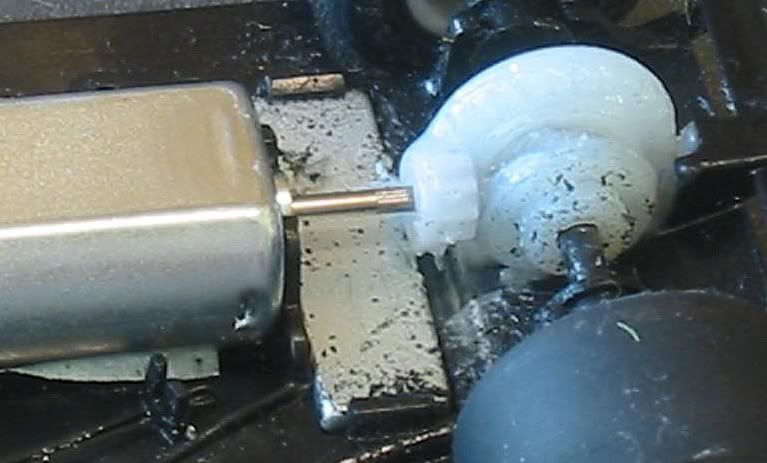
Next trip was to my local board test track, home of the Red Team! A much raced and loved circuit of which I know every inch and know what to expect from a car on it. So onto the grey stuff and off at a pace. Usual procedure, the track has had a fair bit of racing on it to clean it up and now was the moment of truth. Moving off from the grid was OK and round the first right hander onto the straight saw the model hop quite badly in the bend and out of it. Same at the next bend and the same after that. That was a bit disturbing but a quick check and a lengthy sanding of the rear tyres saw everything come good. The model is very quick, quicker than the ‘S’ can Mabuchi F1s, Probably quicker than the earlier Ninco F1’s too. So quick in fact that after several laps of trying to make the car behave, I decided to dial a few ohms into the power supply just to touch base with normality.
With 12 ohms in the power supply the model was lapping in the 7.3’s and unfortunately was becoming airborne at the back straight ‘yump’. It was almost impossible to get a god representative lap and after a while I decided to call it a day as far as lap times were concerned. I dialled in a few more ohms and was contented to drive the model at a furious pace but inside the constraints of the circuit. Still a great model and a beaut to drive but can it be that the ‘F cans are too much of a handful on a drivers circuit? I had a similar problem with the Ninco F1 a long while back but the IRL cars seem fine and still as fast on this track (An IRL has done a 6.9 unofficially on red lane).
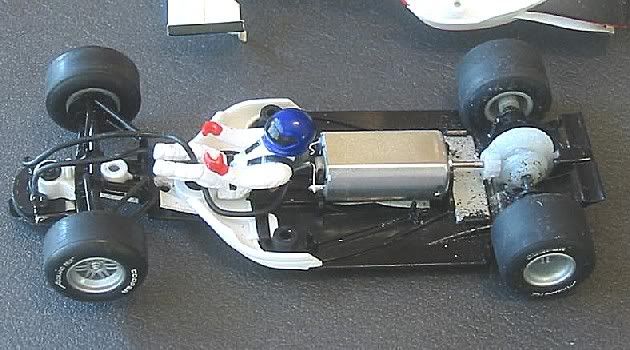
So the conclusion is that this is a very well behaved model on a painted board surface and on a faster track could well prove to be devastating in out of the box condition. The tyres were a bit of a problem but it’s not that long ago when ALL tyres were a problem straight from the box!! Next up was the local Scalextric plastic track. This is the track of a friend and neighbour and it is a very twisty circuit made from and populated buy all things ancient Scalextric. The track is classic plexitrack and the buildings and accessories are all from the sixties period. A very testing drive incorporating both curved and Goodwood chicanes. I put the model on Yellow lane and set off doing some steady laps. This circuit has a good lap time of about seven seconds. F1’s should be able to do it in 6.4 secs and all else falls in behind that.
After a few settling in laps on a track which I know quite well, I decided to up the pace and soon I was lapping in the 6.8’s. This still seemed quite comfortable to me so I further pushed the model harder until it was doing 6.4’s. Sensing there was still more left in it and after some adjustments the model ran faster and faster until it clocked a 6.068 which I was unable to better. At this speed on a twisty circuit, events come thick and fast and probably with a younger driver we might of had a sub 6.0 second lap!! Not to worry, a new lap record and a great model.
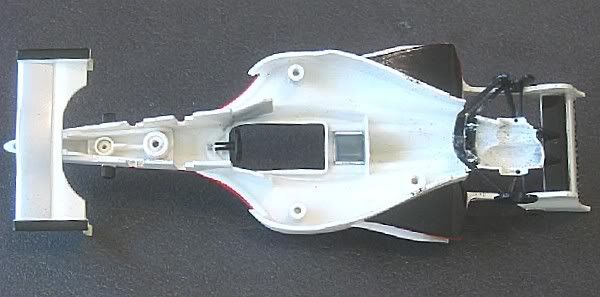
During the testing it was necessary to carry out a couple of minor adjustments. The first was after the model would stop whilst driving slowly and not go again. This was eventually traced to a loss of contact between the braids on the quick change plate and the contacts on the guide. I haven’t experienced this before with these guides and was a bit surprised but after the fix the model seemed to be quicker on all parts of the track too. The other problem was with ground clearance. On the underside of the chassis is a raised centre section. I’ve assumed that it is a replication of a feature on the real car. Possibly something like the ‘plank’ on the underside of the F1 cars.
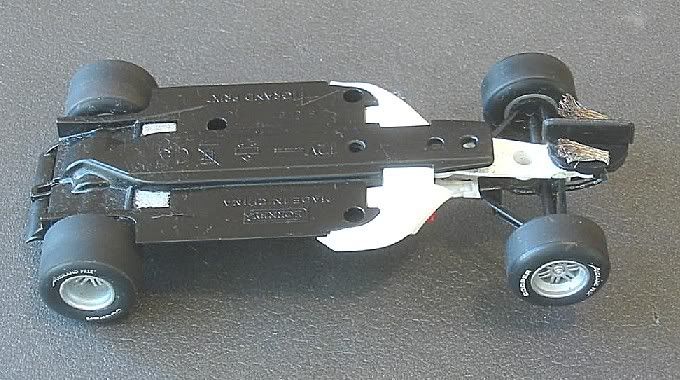
The old Scalextric track is infamous for its variety of faults. Some being the unevenness of rail joints and bits which stick up for no reason. The test track has the superb ‘Grand Bridge’ as part of its features. The car continually got hooked up on the down ramp and its conductor rails. I had been running the model with the body screws a half turn loose but this was more than the track would allow so the test resumed with tightened screws and with fewer minor problems. The Goodwood chicane too was a setback but once you know how to drive it you can get a good shot through it. I can only guess that the tyre truing process the previous Friday had taken the underside close to the rails!!
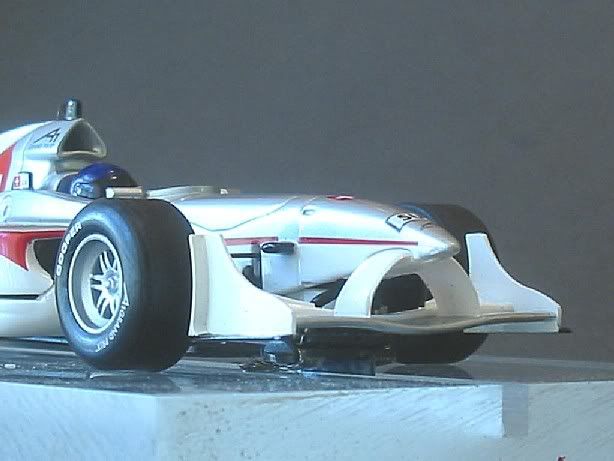
So, a 6.068 was quite a stunning performance and after we raced a Scaley Williams BMW and on the ragged edge we could only achieve a 6.4! The A1 GP’s are certainly going to be used a bit more in my neck of the woods. Now the fear of disintegrating models has been alleviated it’s time to get back down to some serious wheel to wheel action!
Statistics Wheelbase 94.0 mm Front Axle width 57.0 mm Rear Axle width 61.0 mm Overall weight 68.0 grams Front Axle/Guide load 27.0 grams Rear axle load 41.0 grams Front / Rear weight dist 40% / 60% Pinion 9z Contrate 27z Final drive ratio 3 : 1 Rear wheel diameter 21.0 mm Motor Type FF
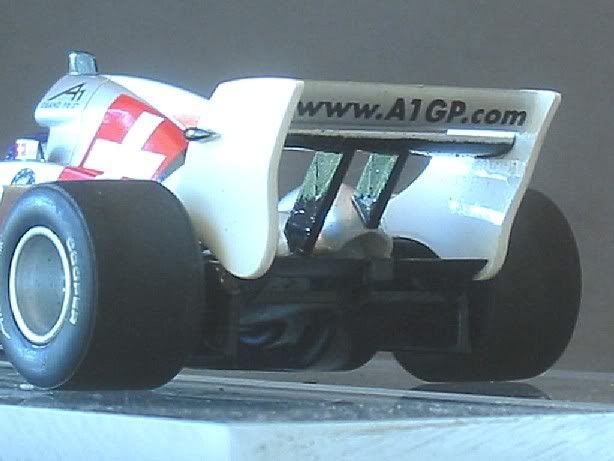
It has been easy to see why open wheeler racing has been in decline in some groups but hopefully the carnage will be consigned to the past with the advent of these great models. The ‘F’ can motor makes them a bit of a projectile on all but the longest of circuits but the new traction magnet ensures that if we are going to be racing at breakneck speeds at least we have the means of staying on! If you haven’t done so already, buy one! Enjoy it!


















